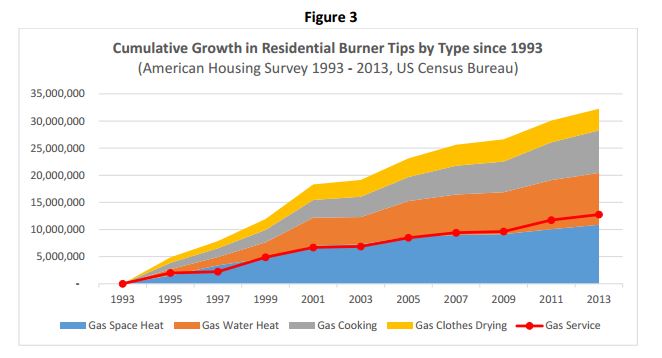The safe development of America’s abundant shale resources is creating game-changing environmental and economic benefits throughout the Commonwealth and beyond. These clear facts were further confirmed in two studies released this week.
As more clean-burning natural gas is safely produced, use among both utilities and consumers is expanding rapidly, according to the American Gas Association’s (AGA) study. In fact, “more homes and businesses use natural gas today than ever before” and utilities are investing in natural gas expansions, allowing more consumers to access this clean-burning, affordable, domestic resource.
Key takeaways from AGA’s report:
- Expanded Consumer Demand: More homes and businesses use natural gas today than ever before and the numbers continue to increase.
- Growing Residential Access: Infrastructure has also expanded as gas utilities have grown the geographic footprint of natural gas service.
- Air Quality Benefits: Companies and regulators are recognizing the growth potential for natural gas as a greenhouse gas emissions reduction tool.
- Lower Energy Costs: Local gas utilities also support conversions from heating oil, propane and electricity, which may lower consumer costs, while reducing energy consumption and emissions.
Additionally, a T2 and Associates study released this week found that the oil and gas sector has been a “driving force behind major U.S. greenhouse gas emissions reductions since 2000”. In fact, according to the study, oil and gas industry investments totaled more than $90 billion – more than any other industrial sector – in technologies aimed at capturing emissions, improved efficiencies, reuse of excess heat, and carbon dioxide sequestration.
Federal data confirms shale’s environmental benefits, as U.S. CO2 emissions are at their lowest point in more than 20-years and, specifically, at 27-year lows in the power sector. These results, coupled with the EPA-reporting 79 percent reduction in methane emissions from hydraulically fractured wells since 2005, are proof positive that shale development is enhancing our environment.
Here’s what else they’re saying about America’s shale revolution and its benefits:
- Gas Companies Expand Water Service to Residents, Businesses: Some gas companies working in the Marcellus and Utica shales are paying to extend public water lines into rural areas. … Homes and businesses along the new water line routes can tap into public service, which will remain long after the drillers leave, and will host fewer water trucks on their roads. “It’s a win-win-win,” said Jack Golding, manager of the SWPA in Greene Co. … “For us, this is a good deal. We get lines extended that would probably never get extended, and it gives us the ability to keep residential rates low.” … “When you’re able to bring drinking water to areas that never, ever would have been able to afford it, it means all the difference in the world,” said state Sen. Scott Hutchinson. … Removing large, expensive water trucks from the road makes both drillers and neighbors happy. (Tribune-Review, 9/20/15)
- Thanks to Shale “New Yorkers Reap Lower Power Bills”: The shale boom has reached the Big Apple. Wholesale on-peak electricity prices for Manhattan and its four neighboring boroughs averaged $40.99 a megawatt-hour since the start of July through Sept. 11. They’re headed for a record third-quarter low, based on Independent System Operator Inc. data going back to 2006. New York power is becoming so cheap that it’s threatening to fall below prices in the area surrounding Washington. … Cheap gas has subdued power prices even as the East Coast experienced waves of unusually hot weather in the second half of summer. … Improved access to supplies from the Marcellus shale deposit in Pennsylvania and other regions is changing the flows on the electric transmission system by reducing the need for the New York grid to import power from PJM Interconnection LLC’s benchmark Western hub. … The benefits are starting to trickle down to consumers. Residential electricity costs for New York fell 10 percent to 18.25 cents per kilowatt-hour in April through June from the same time last year, the least for any quarter since the last three months of 2012, U.S. Energy Information Administration data show. (Bloomberg Business, 9/15/15)
- Natural Gas Provides “Cost Savings for Customers”: The number of homes and businesses using natural gas has grown steadily for decades, AGA said. There were fewer than 40 million residential gas customers in 1970, a number that ballooned to more than 60 million in 2013. The number of gas-fired appliances increased by more than 32 million over the past two decades. “The number of homes that receive natural gas service has grown 22% from 1993 to 2013, or about 1% per year.” Continuing that trend could translate into more than 15 million more customers and 33 million more gas-fired appliances by 2040. Ensuring reliable service to all of those residential customers has required additions to distribution pipeline infrastructure, growing it from 600,000 miles in 1970 to more than 1.2 million miles in 2013. And utility system expansion and modernization has spurred investment, which in turn has grown companies’ enterprise value and financial strength. … AGA estimated the economy-wide value of the natural gas distribution industry grew from $38.2 billion in 1993 to nearly $50 billion last year. … “Natural gas utilities have steadily invested more dollars in energy efficiency for homes and business, which has contributed to decreased usage per customer, growth in energy savings and increased cost savings for customers.” (Natural Gas Intelligence, 9/22/15)





